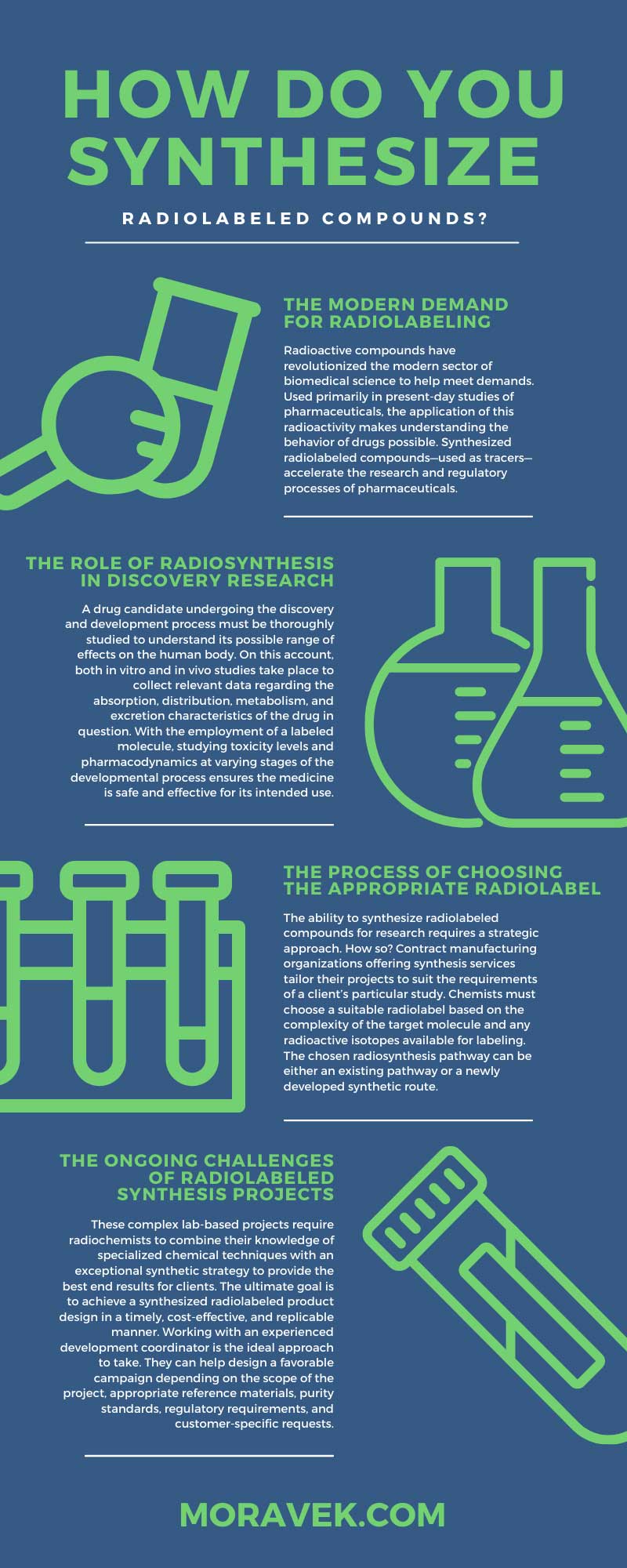
Radiolabeled synthesis is an intricate art and in-depth science. The foundational principles of laboratory synthesis allow radiochemists to achieve multi-step reactions that help with the study of a drug’s disposition. Performing chemical synthesis on radiolabeled compounds in an early stage of a pharmaceutical development timeline provides critical insight for commercial applications.
The exhaustive synthesis process requires industry expertise and scientific precision to avoid prevalent pitfalls and technical mistakes. Those with skilled knowledge and experience in radiochemistry must understand how the labeled compound will be used in research and how to make informed decisions to complete the synthesis process successfully.
How do you synthesize radiolabeled compounds? What exactly does this precise process involve? Developing radiolabeled compounds for clinical studies and drug development research is no simple feat. Uncover how this technique creates life-changing solutions for medical research around the globe.
The Modern Demand for Radiolabeling
The modern medical community has a principal objective: providing the best healthcare solutions to the public to improve patient outcomes. Fortunately, innovations in nuclear medicine and the radiochemistry industry have facilitated increased growth toward this goal.
Revolutionary Medical Applications
Radioactive compounds have revolutionized the modern sector of biomedical science to help meet demands. Used primarily in present-day studies of pharmaceuticals, the application of this radioactivity makes understanding the behavior of drugs possible. Synthesized radiolabeled compounds—used as tracers—accelerate the research and regulatory processes of pharmaceuticals.
Why use a radiolabeled compound for targeted tracing in pre-clinical or clinical trials? A radioisotopically labeled active pharmaceutical ingredient is a fundamental tool for biomedical studies. The ability to effectively trace its non-radioactive counterpart allows researchers to study every characteristic or facet of a given drug’s behavior within a living organism.
The Role of Radiosynthesis in Discovery Research
A drug candidate undergoing the discovery and development process must be thoroughly studied to understand its possible range of effects on the human body. On this account, both in vitro and in vivo studies take place to collect relevant data regarding the absorption, distribution, metabolism, and excretion characteristics of the drug in question. With the employment of a labeled molecule, studying toxicity levels and pharmacodynamics at varying stages of the developmental process ensures the medicine is safe and effective for its intended use.
What the Synthesis of Radiolabeled Substances Involves
Radiolabeled synthesis involves combining raw materials into a new chemical structure for testing. To achieve specific study objectives, skilled chemists replace selected atoms in the compound with a radiolabeled isotope for tracing purposes. As previously mentioned, radiolabeling a compound molecule sets in motion the ability to monitor, track, and assess the metabolism and fate of the drug in living organisms.
Similar to drugs that do not reach the consumer market, many labeled compounds may fail to achieve a clinical study’s desired outcomes. That being the case, the multi-step process of chemical synthesis must be a precise and concise science to achieve success. Radiochemists need to simplify the complexity of syntheses by determining the best synthetic routes and radiolabels to pursue. Then, the production of radiopharmaceuticals can be effective for in-depth research and analysis.
The Process of Choosing the Appropriate Radiolabel
The ability to synthesize radiolabeled compounds for research requires a strategic approach. How so? Contract manufacturing organizations offering synthesis services tailor their projects to suit the requirements of a client’s particular study. Chemists must choose a suitable radiolabel based on the complexity of the target molecule and any radioactive isotopes available for labeling. The chosen radiosynthesis pathway can be either an existing pathway or a newly developed synthetic route.
The preferred radiolabeled synthesis strategy involves employing a known radiolabeled intermediate with an existing pathway. In other situations, designing a categorically new synthesis strategy is the necessary approach to take. In these cases, the length of radiosynthesis increasingly varies, and the cost of services may rise to meet specific needs.
Meeting Labeling Requirements: Key Parameters
Meeting the requirements of a clinical trial or medical research study involves paying attention to several chemical parameters. Before completing synthesis, chemists must use their synthetic expertise to identify the right positioning of the label. For effective application, any radiolabeled drug must also be chemically and metabolically stable. An unstable radiolabel outside of standard parameters could lead to a metabolic profile indicating a toxicological hazard.
Modern radiochemistry methods radiolabel molecules in a wide variety of positions. The exact positioning of the label is important, but placing labels at different positions also enables the tracking of multiple molecules’ biotransformation.
The Ongoing Challenges of Radiolabeled Synthesis Projects
For those requiring services, understand that the challenge of radiolabeled synthesis projects lies in cost-effective customization and the accuracy and quality of the labeled product. Besides locating the exact position of the custom radiolabel for metabolic reasons, maintaining quality standards is another arduous factor to consider. Meeting regulatory requirements with a high-purity radiolabeled compound is essential for a successful study, but synthesis and purification can only be done in a compliant laboratory.
When it comes to a custom synthesis project, technical expertise is a critical asset. Identifying the best radiolabel for a test substance has a dynamic impact on metabolic tracking. The most common radiolabel used in applications is carbon-14. A 14C label is straightforward to use for synthesis, as all life forms contain carbon, but there are other alternatives available for situational medical research.
These complex lab-based projects require radiochemists to combine their knowledge of specialized chemical techniques with an exceptional synthetic strategy to provide the best end results for clients. The ultimate goal is to achieve a synthesized radiolabeled product design in a timely, cost-effective, and replicable manner. Working with an experienced development coordinator is the ideal approach to take. They can help design a favorable campaign depending on the scope of the project, appropriate reference materials, purity standards, regulatory requirements, and customer-specific requests.
The Moravek Approach: Our Radiochemistry Services
Look no further for a trustworthy team to provide excellent value and dependability. Moravek has industry-leading reliability and turnaround times that reduce expenditures. Our extensive expertise in chemical synthetic routes supplies our clients with quality-assured radiolabeled products.
As a contract development and manufacturing organization, Moravek offers custom radiolabeled synthesis services for a relatively limitless range of active pharmaceutical ingredients. Our skilled team of dedicated chemists performs top-quality custom radiolabeling to supply radiolabeled compounds for medical research. With our state-of-the-art equipment, we provide regulatory-compliant services to meet the diverse needs of our clients.

